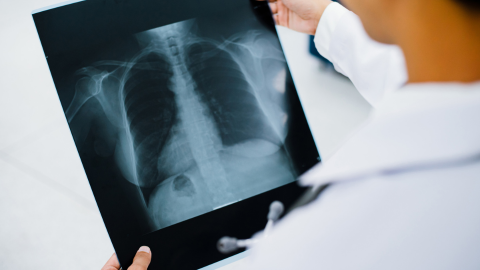Frontal Chest Radiography Interpretation

Frontal Chest Radiography Interpretation
This course includes
The instructors
Overview
Chest radiography interpretation is part of our scope of practice and the skill of radiography interpretation is now expanding into musculoskeletal conditions/disorders. However, when the skill is not commonly used (either due to the lack of time and/or resources a clinician has or the lack of exposure to certain patient populations), clinicians tend to rely on other assessment skills.
Having a consistent method in radiography interpretation allows clinicians to translate the skill to practice and decreases variability between clinicians when interpreting the radiographs.
Relevance to Physiotherapy Practice
Most radiographs when taken are available almost immediately on an electronic viewing system; however, it can take a radiologist hours to days to interpret the radiograph and for clinicians to have access to this report.
Having a consistent method to interpret radiographs allows for physiotherapists to feel successful when viewing radiographs with and without a report, incorporating the skill with their other assessment skills, and using the radiograph as a consistent objective measure.
Learning Objectives
Upon completion of this course participants will be able to:
- Analyze a normal frontal chest radiograph
- Examine a variety of abnormal frontal chest radiographs
- Utilize the 11 step process of chest radiograph interpretation in relation to common respiratory conditions and clinical practice
Audience
This online course is targeted and applicable to the entry-level physiotherapist to the senior therapist/clinical specialist.
Speaker Bio
Simone Gruenig completed her Bachelor of Science at Ottawa University, her Master of Science in Physical Therapy and her Master of Science (research) at the University of Toronto. Her research focused on discharge planning and the high-risk thoracic surgical population.
After working at a major trauma center (critical and acute care) in Toronto, Ontario she relocated to Vancouver, B.C. with her family to work at Vancouver General Hospital where she has held Practice Support and Practice Coordinator positions for the Medical-Surgical Team and clinical therapist positions in the areas of urology, gynecology, solid organ transplant/critical care, cardiac and palliative care.
For the past 7 years she has held the primary Cardiorespiratory Instructor (general, acute care, critical care, and pulmonary rehabilitation populations) and Course Coordinator position at the University of British Columbia in the Department of Physical Therapy, Faculty of Medicine.
She has taught courses in B.C., Alberta, and Ontario in chest x-ray interpretation and general physiotherapy practice with the acute care population. Aside from her work in the realm of cardiorespiratory therapy, she pursues research in the area of multiple student placements; simulated patient learning in regards to the act of suctioning; specializes in women’s health and is the BC wheelchair rugby team therapist.
The instructors

Material included in this course
-
CRD Frontal Chest Radiography Interpretation
-
Welcome and Slides
-
Introduction
-
The 11 Step Process
-
Chest Conditions
-
Case Studies
-
Quiz
-
Feedback
Is a certificate of completion included with this course?
Once you have completed the course, a certificate of completion (including learning hours and course information) will be generated. You can download this certificate at any time. To learn more about course certificates on Embodia please visit this guide.
This can be used for continuing education credits, depending on your professional college or association. If this course has been approved for CEUs in specific jurisdictions, it will be noted on the course page and CEU information may be added to your course certificate. Please read this guide for more information.
I'm a member of the Canadian Physiotherapy Association (CPA). What are the discounts available to CPA Members on Embodia?
As part of our partnership with the CPA, we offer its members discounts on courses and Embodia Memberships. Learn more about the partnership on this page.
In order for the discount to be applied, you first need to authenticate your CPA membership. This is an important step as this is how Embodia 'knows' that you are a CPA member.
To authenticate as a CPA member, you need to sign in the CPA portal on this page, sign in to your CPA account, and then click the button on the page.
Please note that your email address on your CPA account must match your email address on Embodia. If needed, you can update your information on Embodia as outlined in this guide.
